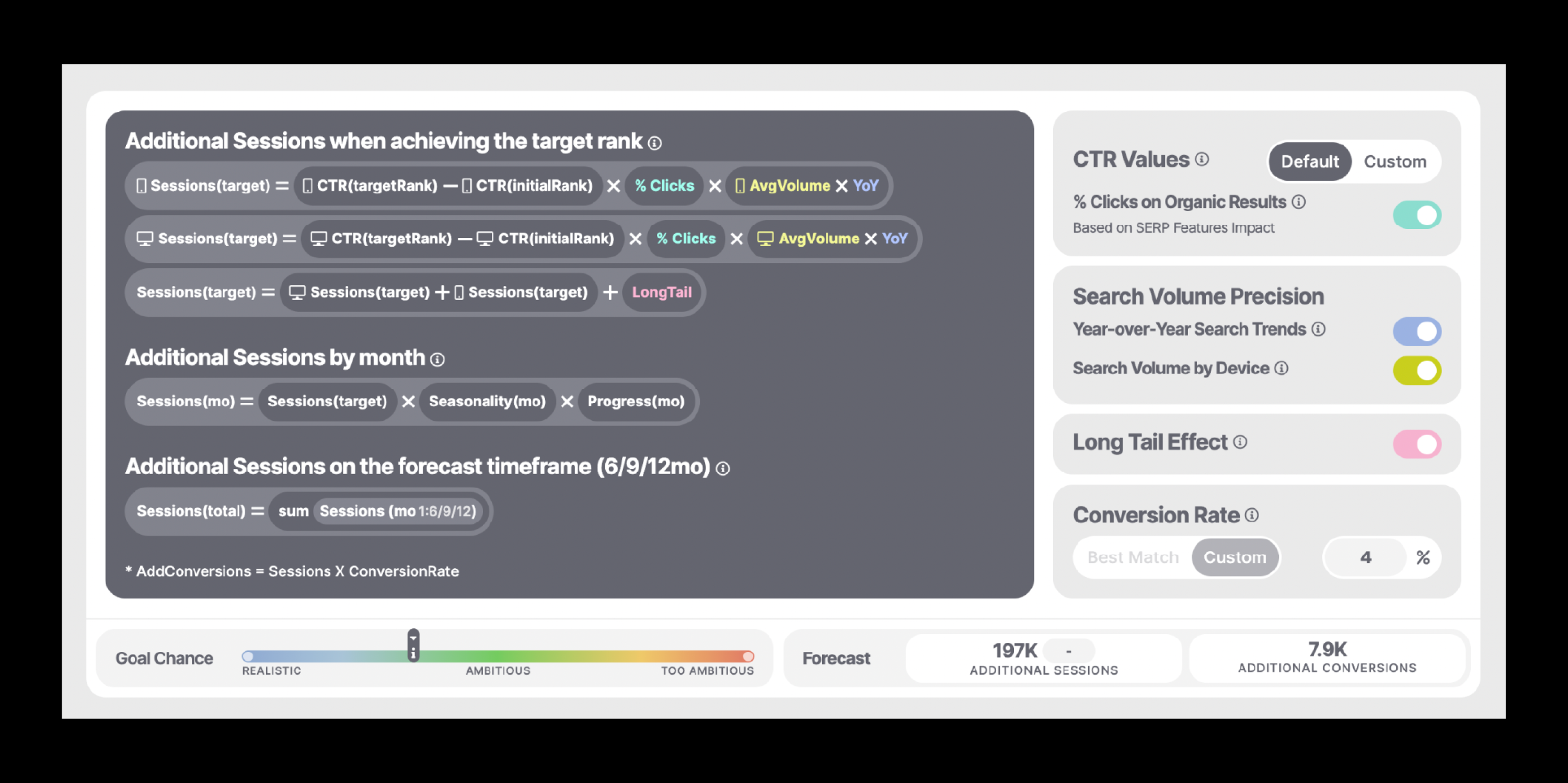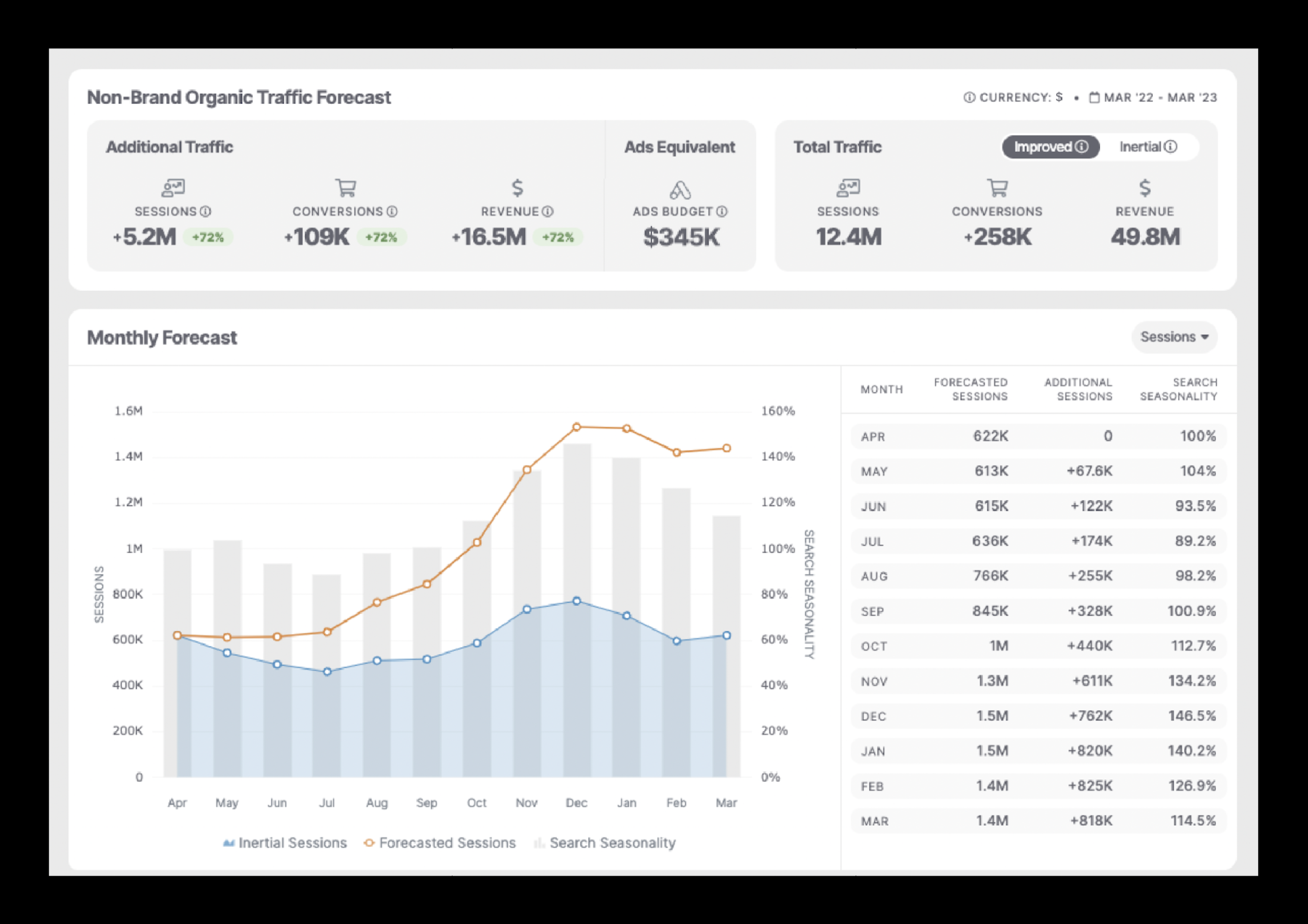The Truth About The Real ROI Of SEO
SEO often involves a significant initial investment with a longer ROI than other channels. And once you let SEO slide, the recovery budget can be even more taxing.
However, the ROI from an investment in SEO is generally higher than in other channels.
You know this, but do your stakeholders?
By displaying the right strategic investment in SEO, your brand will come through a period of economic uncertainty in a much stronger position – poised for growth.
I want to help you prove that to stakeholders.
How To Show Accurately Projected Results That Shareholders & Clients Can Plan Around
It’s your responsibility as the expert to ensure that SEO is a priority.
This can be done through strategic planning that your clients and stakeholders can trust.
Let’s look at two ways you can do that:
- Use SEO forecasting to better predict, select, and validate your marketing objectives, SEO goals, and business goals; with this, you can provide valuable insights to marketing directors, commercial managers, or finance directors.
- Identify hidden or less obvious opportunities for growth through organic search and validate them with SEO forecasting. You’ll show the value of the opportunity and what it means as an investment.
1. Use SEO Forecasting During SEO Strategy Creation To Validate Attainable Goals
Your first step to building your SEO strategy is to choose your goals and objectives.
These goals should be the north star that every part of your strategy works towards.
You’ve probably had to answer questions related to business objectives such as:
- What is the percentage increase in non-brand organic traffic we can expect with an investment?
- If we invest, how much additional revenue or leads will we receive from an increase in our organic search traffic?
- What will our ROI look like in 12 months’ time if we invest in improving our non-brand organic search traffic?
Using SEOmonitor’s Forecast, you’ll be able to answer these questions and secure your value as a thought leader.
Also, you’ll be able to explain these metrics, set expectations, and provide insight into where best to invest your marketing budget.
With the answers to those questions in your pocket, you’ll be able to start building the foundation of a highly-understandable SEO strategy that stakeholders will love.
As I’m personally a fan of the “SMART objectives” framework, I recommend you use it to build out your strategy, as it forces you to consider if your objectives are truly measurable and achievable.
One example to guide you can be: “Increase non-brand organic search traffic by X% within 12 months and Y% within 24 months while improving the website conversion rate for our agreed conversion goals by Z%.”
How To Validate Your SEO Objectives
Let’s look at an example to understand how forecasting helps create and explain these measurable and specific objectives.
In this example, I’m working on a real estate and property website, which I’ll call “Property Search”.
Property Search gets around 5 million organic search sessions a year.
My potential goals are to:
- Maintain and grow the non-brand organic search traffic the site is already receiving.
- Grow the organic, non-branded search traffic for new areas of opportunity.
What I need to answer next:
- What is the percentage increase?
- How would this affect conversions?
- What would an ROI look like in 12 months?
Now that you have your questions in mind, you can use SEO forecasting to help you make sure those metrics and goals are truly attainable.
Define Your Keyword Data On A Granular Level
The more granular you structure your keyword data, the better.
Define your information architecture and group strategic clusters of search phrases together.
SEOmonitor provides a folder and group structure, which helps you set up the level of granularity you need.
- Create Folders: When I set up my keyword research data for “Property Search”, I’ll opt to create individual folders to represent a top-level category in the information architecture (e.g. Offices or Retail).
- Create Groups: Then, inside of each folder, I’ll create groups that represent a sub-category (e.g. For Sale or For Rent).
- Add Keyword Phrase Clusters: To each group, add clusters of keyword phrases that relate to the category or sub-category in question.
- Add To SEOmonitor: These search phrases are either fed into SEOmonitor via Google Search Console and Google Analytics upon account setup or manually via your own keyword research methods.
-
Image by SEOmonitor, September 2022

This level of granularity lets you create different forecast scenarios based on your selection of specific folders or groups. That’s how you can validate relevant metrics against different objectives.
In order to forecast metrics for my first objective – “to maintain and grow non-brand organic search traffic the site is already receiving” – I start the forecasting process in SEOmonitor with the folders and groups I have structured that relate to “Property Search’s” current organic search footprint.
-
 Image by SEOmonitor, September 2022
Image by SEOmonitor, September 2022
Create & Test A Reliable SEO Strategy Scenario
The SEOmonitor forecasting solution provides you with all the key variables you need to create a reliable scenario:
- Timeframe: You’re able to forecast over a 3, 6, and 12-month period.
- Progress Speed: Gain the flexibility to adjust the speed at which you reach your goal: exponential, linear, or custom.
- Volume & YoY Trend: Easily consider average monthly volumes and year-over-year search trends.
- Rank Goal: Set rank position goals at the folder or group level.
- Goal Chance: See how realistic the goal you are setting is, based on your current organic search footprint and the personalized keyword difficulty metric for your targeted website.
A key part of the forecasting process is the ability to adjust the conversion rate in the SEOmonitor forecasting algorithm.
Sometimes, when you’re familiar with a brand, your expertise can help you tailor the forecast toward a more accurate prediction.
For instance, an issue I have come across in the past is conversion data in Google Analytics not matching up to the data in internal systems, in some cases by 20 – 30%. In this instance, adjusting the conversion rate that you are forecasting gives far more accurate metrics in the final forecast.
-
 Image by SEOmonitor, September 2022
Image by SEOmonitor, September 2022
The resulting forecast scenario provides me with all the data needed to answer the questions mentioned above, validate my first objective, and provide valuable insight to my client.
2. Uncover New Business Opportunities With SEO Forecasting
Building on this initial forecast scenario, we can now move our attention to the second objective I outlined: “to grow non-brand organic search traffic for new areas of opportunity.”
How To Identify Gaps In Your Competitor’s SEO Strategy
After extensive research into new areas of opportunity for “Property Search”, and identifying clusters of keyword phrases that related to the business, we identified achievable gaps in the competitors’ landscape.
We consider gaps achievable due to the business’s level of authority in the competitive landscape.
- Import Keyword Phrases & Clusters: We manually import them into SEOmonitor and create a second forecast scenario for our second objective; this forecast will present different metrics so we can validate the opportunity and our second objective.
- Create SMART Objectives: With the two completed forecast scenarios, I have all the metrics we need to create measurable and achievable SMART objectives, thus the ability to validate these objectives and our main SEO goal.
-
 Image by SEOmonitor, September 2022
Image by SEOmonitor, September 2022
3. Use Predicted SEO Forecasts To Help Business Decisions
Working with the Sales Director at “Property Search”, we were able to use the data in the two scenarios to forecast revenue generated from the site based on the increase in conversions.
Based on the estimated increase in non-brand traffic, we are also able to consider the uplift to their display advertising revenue from advertisers on their site.
All of this impacts the ability to forecast better commercials and make decisions at the board level as to the best areas of investment in marketing.
On a final note, you may be wondering why we did not group these two forecast scenarios together, which is a good question.
The reason for this is that the two objectives we had both required different tactics to achieve success for them:
- Our first objective required more significant time and investment in technical and on-page SEO.
- Our second objective had a stronger focus on content and digital PR.
Being able to assign these objectives to specific stakeholders within the “Property Search” team enabled better accountability and clarity on who was responsible for delivery in each area of our strategy.
Use SEO Forecasting To Show Business-Wide Needs For SEO
Forecasting SEO based on keywords and desired ranking targets enables you to set clear, measurable objectives and make a solid business case for:
- Leveraging current non-brand organic traffic.
- Identifying new opportunities to grow the non-brand organic traffic of the business.
That further translates into potential business outcomes that clients and stakeholders care about.
It’s how you turn the conversation from SEO as a cost to SEO as an investment.
With SEOmonitor’s Forecast, which considers all key variables influencing your keywords and ranks (device segmentation, search data including seasonality and year-over-year trends, CTRs, and conversion rates), you can check every calculation and trust the data.
Join us if you want to create greater value for your clients and stakeholders with more transparency and precision.
window.addEventListener( ‘load’, function() {
setTimeout(function(){ striggerEvent( ‘load2’ ); }, 2000);
});
window.addEventListener( ‘load2’, function() {
if( sopp != ‘yes’ && addtl_consent != ‘1~’ && !ss_u ){
!function(f,b,e,v,n,t,s)
{if(f.fbq)return;n=f.fbq=function(){n.callMethod?
n.callMethod.apply(n,arguments):n.queue.push(arguments)};
if(!f._fbq)f._fbq=n;n.push=n;n.loaded=!0;n.version=’2.0′;
n.queue=[];t=b.createElement(e);t.async=!0;
t.src=v;s=b.getElementsByTagName(e)[0];
s.parentNode.insertBefore(t,s)}(window,document,’script’,
‘https://connect.facebook.net/en_US/fbevents.js’);
if( typeof sopp !== “undefined” && sopp === ‘yes’ ){
fbq(‘dataProcessingOptions’, [‘LDU’], 1, 1000);
}else{
fbq(‘dataProcessingOptions’, []);
}
fbq(‘init’, ‘1321385257908563’);
fbq(‘track’, ‘PageView’);
fbq(‘trackSingle’, ‘1321385257908563’, ‘ViewContent’, {
content_name: ‘prove-seo-forecasting-value-seomonitor-spcs’,
content_category: ‘seo sponsored-post’
});
}
});


